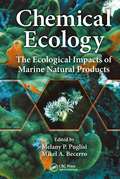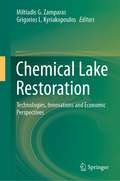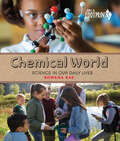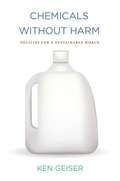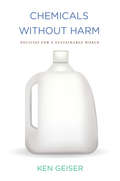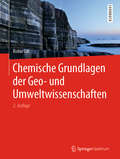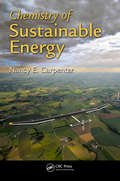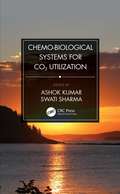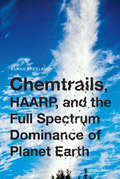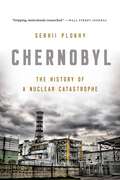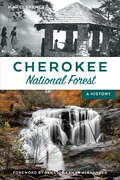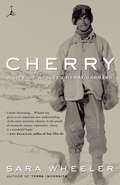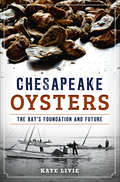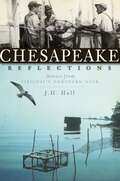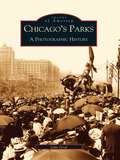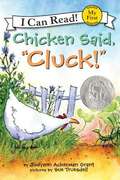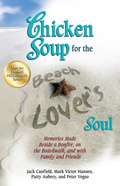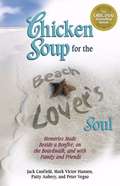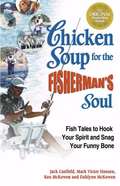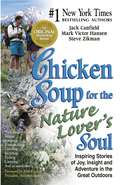- Table View
- List View
Chemical Ecology: The Ecological Impacts of Marine Natural Products
by Melany P. Puglisi Mikel A. BecerroDuring the past 20 years, marine chemical ecology has emerged as a respected field of study providing a better understanding of the role natural products play in organisms and their environments. Ample data in this book advocates the conservation of marine environments for future drug discovery efforts while sustaining their overall health. Marine chemical ecology has expanded to include research in the areas of predator–prey interactions, marine microbial chemical ecology, and seasonal and geographical distribution of marine natural products.
Chemical Lake Restoration: Technologies, Innovations and Economic Perspectives
by Miltiadis G. Zamparas Grigorios L. KyriakopoulosThis book aims to structure, in a complete and sequential way, the mainstream technical knowledge which is related to eutrophication control. The book considers the development of innovative technologies for phosphate removal, while supporting the restoration of currently degraded lakes and reservoir systems. In addition, this book contains key-aspects of future benchmark interests being specially framed under the ongoing development of a circular economy. In particular, the book will contribute to a better understanding of the problem of internal P-loads and P-sources disposition towards a more effective control of nutrients’ enrichment in lakes. The chemical routes and environmental fate of such lake nutrients will be viewed in the light of innovative technologies (engineering dimensions) and circular economy perspectives (economics dimensions). The main theme extends to an economic appreciation of environmental polluted aquifers. The book will appeal to an interdisciplinary audience, covering a wide spectrum of scientific fields, such as environment, physical chemistry, surface chemistry, interfacial phenomena, coastal engineering, bio-engineering, environmental policy makers, and economists.
Chemical World: Science in Our Daily Lives (Orca Footprints #17)
by Rowena RaeDespite people using both natural and synthetic chemicals with (mainly) good intentions, some chemicals have had unintended negative consequences. Chemical residues have contaminated ecosystems the world over and are compromising the health of many ecosystems, animals and humans. The goal of Chemical World: Science in our Daily Lives is to introduce readers to basic chemistry and chemical history, and to show how chemicals are used for particular reasons but sometimes turn out to be harmful to environmental and human health. It invites readers to take a look at the world around them and ask questions about what’s in their environment and how the things they use and eat every day can affect their own health and the planet’s health. Chemical World: Science in Our Daily Lives explores some of the materials—all of which are made of basic chemical elements—that humans use or come into contact with in their day-to-day lives. Some of these chemicals are naturally occurring—clay, mercury, lead. Others have been synthesized by chemists during the past 150 years and used in a bewildering array of products ranging from roof shingles to toothpaste. Many chemical inventions, as well as naturally produced chemicals, have had profound effects on food supply, developing medicines and creating hosts of useful items for modern life. The epub edition of this title is fully accessible.
Chemicals without Harm
by Ken GeiserToday, there are thousands of synthetic chemicals used to make our clothing, cosmetics, household products, electronic devices, even our children's toys. Many of these chemicals help us live longer and more comfortable lives, but some of these highly useful chemicals are also persistent, toxic, and dangerous to our health and the environment. For fifty years, the conventional approach to hazardous chemicals has focused on regulation, barriers, and protection. In Chemicals without Harm, Ken Geiser proposes a different strategy, based on developing and adopting safer alternatives to hazardous chemicals rather than focusing exclusively on controlling them. Geiser reviews past government policies focused on controlling chemicals, describes government initiatives outside the United States that have begun to implement a more sustainable chemical policy, and offers an overview of the chemicals industry and market. He develops a safer chemicals policy framework that includes processes for characterizing, classifying, and prioritizing chemicals; generating and using new chemical information; and promoting transitions to safer chemicals. The shift in strategy described by Geiser will require broad changes in science, the chemicals economy, and government policy. Geiser shows that it is already beginning, identifying an emerging movement of scientists, corporate managers, environmental activists, and government leaders who are fashioning a new, twenty-first-century approach to chemicals.
Chemicals without Harm
by Ken GeiserToday, there are thousands of synthetic chemicals used to make our clothing, cosmetics, household products, electronic devices, even our children's toys. Many of these chemicals help us live longer and more comfortable lives, but some of these highly useful chemicals are also persistent, toxic, and dangerous to our health and the environment. For fifty years, the conventional approach to hazardous chemicals has focused on regulation, barriers, and protection. In Chemicals without Harm, Ken Geiser proposes a different strategy, based on developing and adopting safer alternatives to hazardous chemicals rather than focusing exclusively on controlling them. Geiser reviews past government policies focused on controlling chemicals, describes government initiatives outside the United States that have begun to implement a more sustainable chemical policy, and offers an overview of the chemicals industry and market. He develops a safer chemicals policy framework that includes processes for characterizing, classifying, and prioritizing chemicals; generating and using new chemical information; and promoting transitions to safer chemicals. The shift in strategy described by Geiser will require broad changes in science, the chemicals economy, and government policy. Geiser shows that it is already beginning, identifying an emerging movement of scientists, corporate managers, environmental activists, and government leaders who are fashioning a new, twenty-first-century approach to chemicals.
Chemicals without Harm: Policies for a Sustainable World (Urban and Industrial Environments)
by Ken GeiserA proposal for a new chemicals strategy: that we work to develop safer alternatives to hazardous chemicals rather than focusing exclusively on controlling them.Today, there are thousands of synthetic chemicals used to make our clothing, cosmetics, household products, electronic devices, even our children's toys. Many of these chemicals help us live longer and more comfortable lives, but some of these highly useful chemicals are also persistent, toxic, and dangerous to our health and the environment. For fifty years, the conventional approach to hazardous chemicals has focused on regulation, barriers, and protection. In Chemicals without Harm, Ken Geiser proposes a different strategy, based on developing and adopting safer alternatives to hazardous chemicals rather than focusing exclusively on controlling them. Geiser reviews past government policies focused on controlling chemicals, describes government initiatives outside the United States that have begun to implement a more sustainable chemical policy, and offers an overview of the chemicals industry and market. He develops a safer chemicals policy framework that includes processes for characterizing, classifying, and prioritizing chemicals; generating and using new chemical information; and promoting transitions to safer chemicals. The shift in strategy described by Geiser will require broad changes in science, the chemicals economy, and government policy. Geiser shows that it is already beginning, identifying an emerging movement of scientists, corporate managers, environmental activists, and government leaders who are fashioning a new, twenty-first-century approach to chemicals.
Chemische Grundlagen der Geo- und Umweltwissenschaften
by Robin GillChemische Grundlagen sind die Basis für einen großen Teil der Geowissenschaften. Studierende der Geowissenschaften benötigen daher zunehmend ein solides Verständnis der chemischen Grundlagen, um ihr Studium erfolgreich zu absolvieren. Die erweiterte zweite Auflage dieses beliebten Lehrbuchs führt die Studenten in diese "georelevante" Chemie ein, die in demselben klaren und verständlichen Stil wie die Vorauflage präsentiert wird. Die neue Auflage wurde jedoch um den Bereich der Umweltgeowissenschaften erweitert und enthält ein neues Kapitel, in dem die Isotopengeochemie vorgestellt wird.Das Buch umfasst drei große, gegliederte Teile. Der erste (Kapitel 1-4) befasst sich mit der grundlegenden physikalischen Chemie geologischer Prozesse. Der zweite Teil (Kapitel 5-8) führt in die wellenmechanische Sicht auf das Atom ein und erklärt die verschiedenen Arten chemischer Bindungen, die den Materialien der Erde ihre vielfältigen und charakteristischen Eigenschaften verleihen. Die Schlusskapitel (9-11) geben einen Überblick über die geologisch relevanten Elemente und Isotope und erklären ihre Entstehung und ihre Häufigkeit im Kosmos und auf der Erde. Das Buch schließt mit einem umfangreichen Glossar von Begriffen; die Anhänge behandeln grundlegende Mathematik, erklären die grundlegende Lösungschemie und listen die chemischen Elemente und die im Buch verwendeten Symbole, Einheiten und Konstanten auf.Die Übersetzung wurde mit Hilfe von künstlicher Intelligenz (maschinelle Übersetzung durch den Service DeepL.com) angefertigt. Da die anschließende Überprüfung hauptsächlich im Hinblick auf inhaltliche Gesichtspunkte erfolgte, kann sich der Text des Buches stilistisch von einer konventionellen Übersetzung unterscheiden. Springer Nature arbeitet bei der Publikation von Büchern kontinuierlich mit innovativen Technologien, um die Arbeit der Autoren unterstützen.
Chemistry of Sustainable Energy
by Nancy E. CarpenterUnderstanding the chemistry underlying sustainable energy is central to any long-term solution to meeting our future energy needs. Chemistry of Sustainable Energy presents chemistry through the lens of several sustainable energy options, demonstrating the breadth and depth of research being carried out to address issues of sustainability and the gl
Chemo-Biological Systems for CO2 Utilization
by Ashok Kumar Swati SharmaChemo-Biological Systems for CO2 Utilization describes the most recent advanced tools and techniques for carbon dioxide capture and its utilization. It discusses and compares the advantages of different systems and aids researchers and industrialists in understanding energy generation in the form of biofuels, bioelectricity, or biogas using chemicals; nanomaterials; and microbial, enzymatic, and chemo-enzymatic-integrated systems. It describes the importance and utilization of CO2 in living systems, and provides an overview of the various fundamental methods, policies, and techniques involved in CO2 conversion. Emphasis is placed on the production of value-added products using CO2, including biomethanol, industrial carbonates, and liquid or gaseous fuels. Features: Explains the correlations between microbial, biological, and chemical products and their roles in the conversion of CO2 into usable energy and related products. Being suitable for a broad audience, it addresses fundamental treatment methods for reusing environmental waste materials. Aids in decision-making and policy planning for environmental professionals. The information provided throughout this book will help researchers and professionals working in various industries to better understand the conversion of CO2 into energy-based products. Chemo-Biological Systems for CO2 Utilization also serves as a useful guide to seek alternative methods for clean energy and mitigating global climate change.
Chemtrails, HAARP, and the Full Spectrum Dominance of Planet Earth
by Elana FreelandWe are entering a Space Age, but not the kind President Kennedy originally envisioned. This Space Age is replacing resource wars and redefines planet earth as a "battlespace" in accordance with the military doctrine of "Full-Spectrum Dominance."This book examines how chemtrails and ionispheric heaters like the High-frequency Active Auroral Research Project (HAARP) in Alaska services a full-spectrum dominance. This "Revolution in Military Affairs" needs an atmospheric medium to assure wireless access to the bodies and brains of anyone on Earth--from heat-seeking missiles to a form of mind control.How sinister are these technologies? Are we being prepared for a "global village" lockdown? The recent release of NSA records have reminded Americans that "eyes in the sky" are tracking us as supercomputers record the phone calls, e-mails, internet posts, and even the brain frequencies of millions.Elana M. Freeland's startling book sifts through the confusion surrounding chemtrails-versus-contrails and how extreme weather is being "geo-engineered" to enrich disaster capitalists and intimidate nations.A deconstruction of Bernard J. Eastlund's HAARP patent points to other covert agendas, such as a global Smart Grid infrastructure that enables access to every body and brain on Earth, a "Transhumanist" future that erases lines between human and machine, and Nanobiological hybrids armed with microprocessers that infest and harm human bodies.
Chernobyl: The History of a Nuclear Catastrophe
by Serhii PlokhyFrom a preeminent historian of Eastern Europe, the definitive history of the Chernobyl nuclear disaster On the morning of April 26, 1986, Europe witnessed the worst nuclear disaster in history: the explosion of a reactor at the Chernobyl Nuclear Power Plant in Soviet Ukraine. Dozens died of radiation poisoning, fallout contaminated half the continent, and thousands fell ill. In Chernobyl, Serhii Plokhy draws on new sources to tell the dramatic stories of the firefighters, scientists, and soldiers who heroically extinguished the nuclear inferno. He lays bare the flaws of the Soviet nuclear industry, tracing the disaster to the authoritarian character of Communist party rule, the regime's control of scientific information, and its emphasis on economic development over all else. Today, the risk of another Chernobyl looms in the mismanagement of nuclear power in the developing world. A moving and definitive account, Chernobyl is also an urgent call to action.
Cherokee National Forest: A History (Natural History)
by Marci SpencerExplore the sacred homeland of the Cherokee people Created in 1920, the 650,000-acre Cherokee National Forest lies north and south of the Great Smoky Mountains National Park. Located in the sacred homeland of the Cherokees, it pays tribute to its heritage in its name and protects ancient indigenous burial caves and portions of the Trail of Tears. By car, foot, horse, or watercraft, visitors explore the natural beauties of the region, such as the Roan, Max Patch, Unicoi, and Unaka mountains and the Ocoee, Hiwassee, Nolichucky, Watauga, and French Broad rivers. The Appalachian, Benton MacKaye, and John Muir trails and other pathways lead to mountain-top views, rock cliffs, forested coves and gardens of abundant wildflowers. Local author Marci Spencer tells the stories of these wonders and the early settlers, railroad workers, loggers and miners who lived and worked among them.
Cherry: A Life of Apsley Cherry-Gerrard
by Sara WheelerThe first authorized biography of the antarctic explorer who gave us the greatest classic of polar literature. In February 1912, Apsley Cherry-Garrard drove a team of dogs 150 miles to a desolate outpost on Antarctica's rough ice shelf to meet Robert Falcon Scott and his men, who were expected to return victorious any day from their epic race to the South Pole. Winter was closing in, and Cherry was handicapped by brutal temperatures and diminishing light. Less than two weeks later, three dying men pitched their tent for the last time just twelve miles to the south. One was Captain Scott, the leader of the expedition. The other two, Birdie Bowers and Bill Wilson, were the closest friends Cherry had ever had. Ten months later, once the polar winter had released them from captivity, Cherry and his search party found the tent, piled with snow and pinned to the ice by his friends' corpses. It was a tragedy that would rever-berate around the world and inspire Cherry to write his masterpiece,The Worst Journey in the World, which recently toppedNational Geographic's list of the 100 greatest adventure books of all time. Cherry discovered in his writing a means to work out his grief and anger, but in life these doubts and fears proved far harder to quell. As the years progressed, he struggled against depression, breakdown, and despair, and was haunted by the possibility that he alone had had the opportunity to save Scott and his friends. Sara Wheeler'sCherryis the first biography of this soul-searching explorer, written with unrestricted access to his papers and the full cooperation of his widow -- who has refused all requests until now. Wheeler's biography brings to life this great hero of Antarctic exploration and gives us a glimpse of the terrible human cost of his adventures.
Chesapeake Bay Walk
by David Owen BellFrom the Book Jacket: What Awesome Chesapeake does for older children, this book will do for youngsters ages four to nine-awaken them to the wonders of the Chesapeake Bay and the life in and around it. Written by the same author, Chesapeake Bay Walk takes young children and their parents or teachers on an unforgettable shoreline journey. On a stroll through its pages, they can find soft-bellied bullies, birds once hunted for their feathers, crabs older than dinosaurs, "bald" five-year-olds, and living prehistoric creatures made of water. David Owen Bell, author of Awesome Chesapeake and Chesapeake Bay Walk, has been involved in children's outdoor education for many years. Jennifer Heyd Wharton, a watercolorist, has also illustrated four children's books.
Chesapeake Oysters: The Bay's Foundation and Future (American Palate)
by Katherine J. LivieThis cultural and ecological history explores the rise of Chesapeake&’s mighty mollusk from Colonial-era harvesting to contemporary cultivation. Oysters are an essential part of Chesapeake Bay culture and cuisine, as well as the ecological and historical lifeblood of the region. When colonists first sailed these abundant shores, they described massive shoals of foot-long oysters. In later years, however, the bottomless appetite of the Gilded Age and great fleets of skipjacks took their toll. Disease, environmental pressures, and overconsumption decimated the population by the end of the twentieth century. To combat the problem, Virginia began leasing its waters to private oyster farmers. Today, these boutique oyster farms are sustainably meeting the culinary demand of a new generation of connoisseurs. But in Maryland, passionate debate continues among scientists and oystermen whether aquaculture or wild harvesting is the better path. With careful research and interviews with experts, author Kate Livie presents this dynamic story and a glimpse of what the future may hold.
Chesapeake Reflections: Stories from Virginia's Northern Neck
by J H HallOne man celebrates and laments his family&’s connection to a disappearing paradise of natural wildlife and beauty on the shores of Chesapeake Bay. Between the Indian and Dividing Creeks, near the mouth of the Rappahannock River in Virginia&’s Chesapeake Bay, sits a parcel of land called Bluff Point. Like most bay-front villages, the bountiful resources and majestic landscape of this area that once sustained watermen and sportsmen alike have been depleted as over-harvesting, poaching, pollution and continued development have taken their toll, threatening the very legacy of its people. J. H. Hall&’s family first settled on this land shortly after the Civil War, where they maintained a tradition of farming, fishing and crabbing throughout the twentieth century. Hall&’s words flow as splendidly as the tides in this collection of personal reminisces and local and natural history honoring the lives of the watermen before him and the uncertainty surrounding those today.
Chiapas: Reconciling Agriculture and Ecology
by Juan Enriquez Ray A. GoldbergChiapas: Reconciling Agriculture and Ecology by Ray A. Goldberg and Juan Enriquez-Cabot
Chicago's Parks: A Photographic History
by John GrafNo other city in the world has a park system as great as Chicago's, which includes over 550 parks totaling more than 7,000 acres. Each park has its own story, as well as unique characteristics and history, and yet the majority of Chicagoans are not aware of the wealth, variety, and sheer number of parks that exist, to say nothing of the ideas theyproject, the history they commemorate, and the origins of their names. Chicago's Parks: A Photographic History seeks to remedy this oversight. From Chicago's first park, Dearborn Park, to its more famous parks of Grant and Lincoln, this book provides a wealth of information concerning the origins of the names and plans of these Chicago landmarks. A formal plan for the creation of a park system was developed in 1869, and soon Chicago had some of the greatest parks to be found anywhere in the world. When Chicago was founded in 1837, the city's fathers adopted the motto urbs in horto, or "the city set in a garden." Despite the numerous changes that have taken place over the past 160 years, Chicago is still a city set in a garden. Chicago's Parks: A Photographic History captures the growth of that "garden" with its nearly 200 historic photographs.
Chick Life Cycle (Science Vocabulary Readers)
by Elizabeth BennettLearn more about how an egg becomes a chicken.
Chicken Said Cluck (I Can Read)
by Judyann Ackerman GrantGrant's simple text and Trues dell's appealing and vibrant art come together to tell a tale of Chicken's determination and triumph over grasshoppers that invade the pumpkin patch. Full color.
Chicken Soup for the Beach Lover's Soul
by Jack Canfield Mark Victor Hansen Patty Aubery Peter VegsoOpen your heart to the magic found at the water's edge ...There are many places we can go to enjoy time with friends, to have an action-packed vacation, or to enjoy a little solitude, but none of them have the same ability to soothe our souls as the beach. Perhaps it's the magic portrayed by children building sand castles or the gentle sounds of lapping waves on the shore. Chicken Soup for the Beach Lover's Soul is filled with recollections of special moments that will be appreciated by anyone who has been mesmerized by the spell of the ocean. Color photos of magnificent beach destinations across the United States, from the quaint, historic surroundings of Cape May, New Jersey, to the sultry scenes of Big Sur, California, capture the magic of America--from sea to shining sea. This unique compilation conjures up memories of family beach outings, the joy of finding a spectacular seashell, young love discovered on the sand, and mature love rekindled at the seashore. Join us on this journey of beaches far and near and remember the fun and excitement you found there, and be inspired to create new memories.
Chicken Soup for the Beach Lover's Soul: Memories Made Beside a Bonfire, on the Boardwalk and with Family Friends
by Jack Canfield Mark Victor Hansen Patty Aubery Peter VegsoOpen your heart to the magic found at the water's edge. There are places we can go to enjoy time with friends, to have an action-packed vacation, or to enjoy a little solitude, but none of them have the same ability to soothe our souls as the beach.
Chicken Soup for the Beach Lover's Soul: Memories Made Beside a Bonfire, on the Boardwalk, and with Family and Friends
by Jack Canfield Mark Victor Hansen Patty Aubery Peter VegsoOpen your heart to the magic found at the water's edge . . . There are many places we can go to enjoy time with friends, to have an action-packed vacation, or to enjoy a little solitude, but none of them have the same ability to soothe our souls as the beach. Perhaps it's the magic portrayed by children building sand castles or the gentle sounds of lapping waves on the shore. Chicken Soup for the Beach Lover's Soul is filled with recollections of special moments that will be appreciated by anyone who has been mesmerized by the spell of the ocean. Color photos of magnificent beach destinations across the United States, from the quaint, historic surroundings of Cape May, New Jersey, to the sultry scenes of Big Sur, California, capture the magic of America--from sea to shining sea. This unique compilation conjures up memories of family beach outings, the joy of finding a spectacular seashell, young love discovered on the sand, and mature love rekindled at the seashore. Join us on this journey of beaches far and near and remember the fun and excitement you found there, and be inspired to create new memories.
Chicken Soup for the Fisherman's Soul: Fish Tales to Hook Your Spirit and Snag Your Funny Bone
by Mark Victor Hansen Jack L. Canfield Dahlynn Mckowen Ken MckowenMore than fish tales in this delightful book, readers will discover stories about the special relationships that develop through fishing--between parents and children, between friends and lovers, between fisherman, nature, and the elusive fish. Fishing is a common thread in many lives, and this book shows the strength and importance of those threads--whether your passion is fly-fishing, bass fishing, deepwater fishing, or just casting a line on a hot summer day. Chapters include: First Cast, Small Fries, The One That Got Away and Hooked For Love.
Chicken Soup for the Nature Lover's Soul
by Jack Canfield Mark Victor Hansen Steve ZikmanFor anyone who enjoys spending time in the great outdoors: hikers, mountain climbers, snowboarders, kayakers, campers, beach-lovers, tree-huggers, and more! Stories of adventure are complemented by tales of introspection and quiet moments that focus on the exhilaration of bonds created outdoors and the beauty of natural landscapes.
